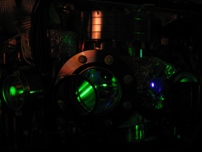We have two main research laboratories. In the first, we cool and trap a mixture of two different atomic species
(lithium and ytterbium) for studies with interacting ultracold mixtures and with ultracold molecules. In the
second apparatus, we cool ytterbium atoms to degeneracy and perform atom optics and interferometry experiments.
Our research with ultracold atoms and quantum gases can be broadly divided into the three areas discussed
below. More details can be found in the
publications page.
Ultracold Few-Body Physics
Few-body interactions form the microscopic mechanisms responsible for much of the phenomena in the material universe. The capabilities
of interaction tuning and time-dependent observability make the ultracold atoms platform well-suited for the study of fundamental
few-body physics. A recent example of work that we have performed in this area are the conversion of atoms of Yb and Li into molecules
of YbLi using laser fields in a photoassociation process [1]. Another example is the observation and study of magnetic Feshbach
resonances in collisions of fermionic Yb and fermionic Li where the temperature dependance of the three-body rate revealed a signature
of Fermi statistics [2]. The understanding and control of such few-body interactions are of importance in the areas of quantum simulation
and quantum information science. Our efforts in this area are enhanced by collaborations with the theoretical groups of Profs
Svetlana Kotochigova (Temple University) and Eite Tiesinga (NIST).
Quantum Dynamics and Quantum Simulation
Quantum systems when taken out of equilibrium can exhibit rich dynamical behavior. The flexibility of ultracold atomic platforms allows the
implementation of precise external drives and time-dependent observation. Our recent work in this area includes the study of single-particle
dynamics of atoms in a moving optical lattice (Bloch oscillations) for the purpose of improving quantum interferometric sensors [3]. Another
example is our creation of Bose-Fermi double superfluids and driving and observing collective many-body dynamics in their motion, including
the exchange of angular momentum between superfluids [4]. Recently, using a combination of static and pulsed optical lattices, we have observed the phenomenon
of interaction-driven dynamical delocalization and many-body quantum chaos [7]. Our experiment forms an analog quantum simulator of many-body transport.
Atom Optics and Interferometry
In a manner analogous to light waves, atom waves can also be manipulated with "atom" optics and split, recombined, and made to interfere. When
ultracold atoms or Bose-Einstein condensates (narrow "linewidth" atom lasers) are employed as the atom source, the resultant high quality
interference signals can be used towards sensitive measurements of atomic properties as well as external forces. We have developed a
three-path atom interferometer geometry suitable for measuring the fine structure constant and testing quantum electrodynamics [5]. Recently,
we have been utilizing a quantum transport approach to improve the precision of atom interferometric measurements [6,3].
References
(see
publications page for more)
[1] Alaina Green, Jun Hui See Toh, Richard Roy, Ming Li, Svetlana Kotochigova, and Subhadeep Gupta,
Two-photon photoassociation
spectroscopy of the Doublet-Sigma YbLi molecular ground state,
Phys. Rev. A 99, 063416 (2019).
arXiv:1903.00603.
[2] Alaina Green, Hui Li, Jun Hui See Toh, Xinxin Tang, Katherine McCormick, Ming Li, Eite Tiesinga, Svetlana Kotochigova, and Subhadeep Gupta,
Feshbach resonances in p-wave three-body recombination within Fermi-Fermi mixtures of open-shell 6Li and closed-shell 173Yb atoms,
Phys. Rev. X 10, 031037 (2020).
arXiv:1912.04874.
[3] Katherine McAlpine, Daniel Gochnauer, and Subhadeep Gupta,
Excited-band Bloch Oscillations for Precision Atom Interferometry,
Phys. Rev. A 101, 023614 (2020).
[4] Richard Roy, Alaina Green, Ryan Bowler, and Subhadeep Gupta,
Two-element mixture of Bose and Fermi superfluids,
Phys. Rev. Lett. 118, 055301 (2017).
[5] Benjamin Plotkin-Swing, Daniel Gochnauer, Katherine McAlpine, Eric Cooper, Alan Jamison, and Subhadeep Gupta,
Three-path atom interferometry with large momentum separation,
Phys. Rev. Lett. 121, 133201 (2018).
arXiv:1712.06738.
[6] Daniel Gochnauer, Katherine McAlpine, Benjamin Plotkin-Swing, Alan Jamison, and Subhadeep Gupta,
Bloch-band Picture for Light Pulse Atom Diffraction and Interferometry,
Phys. Rev. A 100, 043611 (2019).
[7] Jun Hui See Toh, Katherine C. McCormick, Xinxin Tang, Ying Su, Xi-Wang Luo, Chuanwei Zhang, and Subhadeep Gupta,
Many-body Dynamical Delocalization in a Kicked One-dimensional Ultracold Gas,
Nature Physics 18, 1297 (2022).



